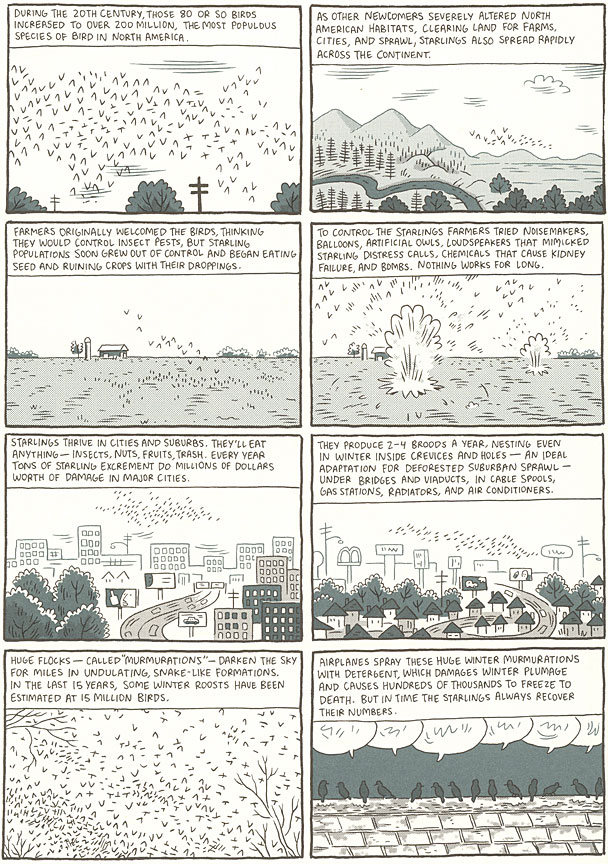Many of the features that lead some people, and I count myself among them, to consider Kevin Huizenga the most exciting living maker of comics are on display in Curses, a new collection of short works. Huizenga's stories often interpolate an outside text: "The Curse" retells the story of starlings being brought to America; "28th Street" updates an Italian folktale; and "Green Tea (Glenn Ganges Remix)" adapts a Gothic story by J. Sheridan LeFanu. The best of these suspend the interpolated text in a larger narrative trajectory that enriches the narrative it intersects. Take "The Curse," for example: starlings have overtaken author-stand-in Glenn Ganges' neighborhood, allowing for a series of interlocking non-fiction digressions. First, we read about the introduction of starlings to America by Eugene Schieffelin, who thought to populate the continent with all the flora and fauna mentioned in Shakespeare's plays. The number of starlings of course exploded—the initial eighty birds begat a current population of over 200 million—in Huizenga's hands a fitting symbol of rapid and out of control development. Starlings are talented mimics, so when Huizenga follows up with the information that in West Michigan, where his story is set, starling songs are made up "30-50% [with] sounds related to automobiles," it's hard not to connect the overpopulation of starlings with the frenzied development, by car especially, of our urban environments.
The overdevelopment of small urban communities becomes a recurring visual feature of Huizenga's work, present when it's overtly referred to in the text (as in "28th Street") but still visible when it's not, when it operates to elaborate a point adjacent to what the text reports. This two-voiced harmony between text and image, the one playing against the other, is one of Huizenga's strengths. Likewise, he uses design systems to develop ideas that would be hard to communicate verbally: in the story "Lost and Found," we see Ganges increasingly haunted by the pictures of children from those "Have you seen me?" postcards. The faces, and the mystery of their current whereabouts, crowd him nearly out of the panel. This idea likely could be communicated in text alone, but the elegant use of image makes the point so quickly.
This isn't to say that Curses is a perfect collection. The interplay between the tranquil images in the Japanese Meija style and the text taken from adoption papers that makes up "Case 0003128-54" remains opaque, at least to this reader. And "Jeezoh" describes a funeral tradition so self-consciously bizarre that it's more gimmicky than resonant. That story is also burdened by the off-panel death of the child Glenn and wife Wendy strove for through most of these stories, and perhaps the emotional weight of that plot point overpowers the story. "Jeepers Jacobs," a story I love for its intellectual seriousness, hasn't worked out an appealing visual system to illustrate the texts it introduces about Hell and the afterlife, so we read pages of talking heads saying fascinating stuff. The story needs more than conventional images of lakes of fire, but Huizenga hasn't yet found what those images should be.
These reservations aside, however, this is a collection where again and again synchronicities of text and intertext, of image and word, are both formally exhilarating and emotionally rewarding.
From Curses:

